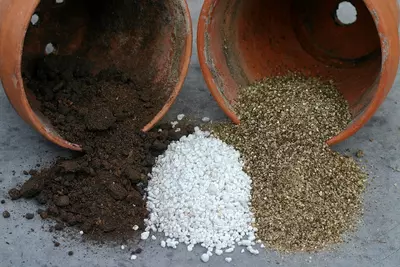
If you’ve ever looked up how to sow seeds, take cuttings or even re-pot a house plant, you’ve probably come across references to vermiculite and perlite. These two handy substances are a boon to gardeners. They can make compost drain better and also retain moisture, even though that sounds like a contradiction. So what are vermiculite and perlite, how do they work, and which should you choose? Here’s all you need to know.
What is perlite?
Perlite is a white granular material that is made by heating volcanic glass until it expands and ‘pops’, like popcorn. It is sterile, lightweight and has a neutral pH, so it’s very easy to work with. When mixed with compost, it traps air pockets in the compost, which improves drainage. Perlite is often used in propagating cuttings, where free-draining compost is needed, or in sowing seeds. Because it is porous, perlite absorbs water and can be used to improve moisture retention in compost, but its primary use is to improve drainage.
What is vermiculite?
Vermiculite is produced by heating a naturally occurring mineral (magnesium aluminium iron silicate) so that it expands. Horticultural vermiculite looks like small golden-brown flakes. It can absorb up to four times its own weight in water and will also absorb some minerals that plants need, such as potassium, magnesium and calcium. Vermiculite is better for water retention than perlite and is ideal for potting up plants that need moist compost. It is sold as medium or fine grade – medium grade is better used in cuttings composts and fine grades in seed sowing.
NB: Don’t get horticultural vermiculite (sold in garden centres) mixed up with the vermiculite insulation granules sold in hardware stores – they are not interchangeable!
How to use perlite
Perlite is most often mixed with composts to improve drainage. Here are a few of the most common uses:
-
A 1:4 mix of perlite and compost makes a free-draining potting medium ideal for succulents.
-
Softwood and semi-ripe cuttings will root well in perlite. Part-fill, a plastic bag with moistened perlite, insert the cuttings and seal the bag. After several weeks, roots will start to form. Once the roots are well developed, the cuttings can be potted on.
NB: Perlite is very dusty, so dampen it with water before using it to avoid inhaling the dust.
How to use vermiculite
Vermiculite is mainly used to improve moisture retention. Here are a few examples:
-
A 50/50 mix of compost and vermiculite is perfect for houseplants that need a lot of water, such as maidenhair fern.
-
30% medium-grade vermiculite added to compost makes a suitable medium for cuttings and potting on seedlings.
-
Scattering a light covering of vermiculite on compost after sowing seeds helps keep moisture in and reduces the risk of ‘damping off’ when seedlings are attacked by a fungus that causes them to collapse.
Vermiculite and perlite are just two of the many valuable products you’ll find in our centre. Visit us today for all your gardening needs!




